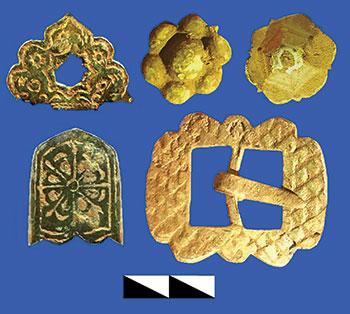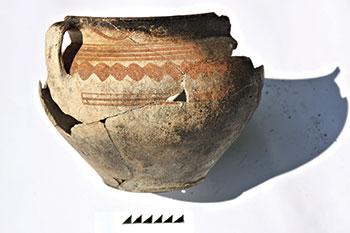PART.2
Research on the Honcharivka palace’s floor pavements has shown that there were at least nine rooms, halls, vestibules, corridors, storage areas and the like on the ground and upper levels, as well as five vaulted chambers, a corridor and a staircase in the basement. I surmise that the basement had a brick floor and that it stored the state/military and hetman’s private treasuries. The ground floor was paved with elongated six-angled ceramic tiles combined with square tiles all covered by green enamel. A gala hall for official receptions, council meetings and banquets could have been situated on this ground level.
On the second and third stories and mansard, were likely located the bedchambers and living quarters of Mazepa and his wife (“hetmanova”) Hanna, the hetman’s office, his private and general military chancelleries, a library and the state archives. Presumably the floors there were made of ornate ceramic square and octagonal tiles faced with common flask-green and rare blue enamel, as well as unusual bicolor half terracotta-half glazed apple-green tiles. Mazepa and his wife may have personally selected the shapes and colors of these tiles and inlays for the floors. Cheaper ceramic floor tiles without glazing were apparently used in the less important and more modestly furnished service premises and rooms for servants or guests.
 Bronze decorative appliqués and clasp from belts of Kozak officers, unearthed at the site of early 18th-century barracks in 2014. (Photo by Yurii Sytyi)
Bronze decorative appliqués and clasp from belts of Kozak officers, unearthed at the site of early 18th-century barracks in 2014. (Photo by Yurii Sytyi)
Examples of early modern floor designs and inlays comparable to those discovered at the Honcharivka palace have been found in St. Sophia Cathedral (the 17th-century floor in its altar apse) in Kyiv; the Holy Trinity Cathedral (1675) at the Hustyn Monastery in Chernihiv Oblast; the 16th-18th century castle of the Ostrozky princes in the town of Ostroh, Rivne Oblast, Ukraine; as well as the residences of Polish kings on Wawel Hill in Krakow and the Wilanow district of Warsaw (1696). In my conclusion, the principal residence of Mazepa in Baturyn was his largest and most lavishly embellished secular building, as well as an outstanding piece of both the palatial architecture and the ceramic decorative art of the Kozak state.
In 2014, our expedition finished excavating the remnants of a sizeable elongated timber structure (19 by 5 meters) which stood at Mazepa’s estate in Honcharivka. Perhaps this was the military barracks, or “kurin,” that housed either members of the hetman’s bodyguard (“serdiuky”) or Kozak officers (“starshyna”) from his retinue. At this building were found: silver and copper Polish and Russian coins, bronze buttons, a clasp and four figured belt appliqués with relief floral patterns and engravings, a lead musket and pistol bullets, iron heel plates for boots, ceramic Kozak tobacco pipes of local manufacture, fragments of German glazed tableware and Dutch porcelain chibouks and mouthpieces from the 17th-18th centuries.
 Restored 17th-18th century pot, decorated with an ochre design, from excavations near the cemetery of the Trinity Cathedral in 2013. (Photo by Volodymyr Mezentsev.)
Restored 17th-18th century pot, decorated with an ochre design, from excavations near the cemetery of the Trinity Cathedral in 2013. (Photo by Volodymyr Mezentsev.)
On the basis of 16 bronze clasps and appliqués unearthed at this site in 2011-2014, this author and Mr. Dmytriienko have prepared hypothetical computer reconstructions of five ornamented leather belts of wealthy Kozak officers. These could have been the work of artisans from Baturyn or some other center of crafts in the Hetmanate.
The Kozak elite was the main consumer of costly local white-clay tobacco pipes and those of Dutch porcelain. The great quantity of such pipes found in the barracks provides additional argument that its residents belonged to the officer class. Thus, the excavations of this edifice have enriched our knowledge about the armament, accoutrement, consumption of domestic and imported goods, the prosperity, culture, lifestyle and customs of Kozak officers at Mazepa’s court.
 Flint and bronze screw from a rifle, an iron arrowhead, a splinter from an iron cannonball and lead musket bullets, pre-1708, from excavations of the military barracks at Mazepa’s manor in 2013. (Photo by Volodymyr Mezentsev.)
Flint and bronze screw from a rifle, an iron arrowhead, a splinter from an iron cannonball and lead musket bullets, pre-1708, from excavations of the military barracks at Mazepa’s manor in 2013. (Photo by Volodymyr Mezentsev.)
Mr. Sytyi’s archaeological explorations in 2014-2015 revealed the site of the Church of the Presentation of the Mother of God near the extant masonry residence of Judge General Vasyl Kochubei in Baturyn’s western suburb. He built this church with squared oak logs in the late 17th century. It survived the Muscovite onslaught on the hetman capital. In 1778, Rozumovsky ordered that the Presentation Church be dismantled and reassembled in the neighboring village of Matiyivka. Soviet authorities demolished this monument of wooden Ukrainian folk architecture in 1933.
Last year, north of the former Baturyn fortress, in the market square, Mr. Sytyi’s excavations uncovered the foundations of an unidentified 18th century structure. Its foundation trenches were filled with broken 17th century bricks, many of which exhibit fire damage. This researcher suggests that these burnt bricks came from the masonry of St. Nicholas Church. Mazepa donated 4,000 gold coins (“zoloti”) for its construction. This church stood somewhere within the present-day market square and probably suffered from the conflagration of the town in 1708. Rozumovsky dismantled its ruins and reused the bricks for his buildings.
In 2014, in the fortress east of the site of the Holy Trinity Cathedral (1692), which was endowed by Mazepa and destroyed by the tsarist forces, remnants of the 17th-18th century storage structures of well-to-do burghers were excavated. Archaeologists found there: low-denomination Polish silver coins, fragments of refined plates made from milk-glass and painted with polychrome plant motifs (likely a Turkish imitation of expensive chinaware), iron and bone buttons, two ceramic gaming chips and shards of terracotta stove tiles of local production of this time. Archaeological finds of imported goods testify to the broad commercial and cultural contacts of Baturyn with Northern, Central and Eastern Europe, as well as the Islamic East, prior to 1708.
In the fortress, three tiny terracotta human figures have been unearthed. The lower parts, arms and the head of one of them are broken off. Their body shapes, facial features and head dress were coarsely and naïvely executed. The modeling technique of these images shows no influences of realistic Baroque or neoclassical sculpture.
Presumably these rare artifacts represent distinctive vernacular toys created by a local Baturyn potter during the Rozumovsky era. Clay female statuettes from the 14th to 18th centuries have been found in Kyiv, Vyshhorod, Bila Tserkva and Baturyn. An early modern terracotta anthropomorphic figurine comparable to those described above was discovered in the village of Ulanovo, Hlukhiv region, Sumy Oblast, in 2009. According to analysis, toys of this design and technique were manufactured in Baturyn, Hlukhiv and possibly other centers of pottery-making in the Chernihiv and Sumy regions in the 18th-19th centuries. These pieces may indicate a revival of ceramic folk art in Baturyn during its reconstruction by Rozumovsky in the second half of the 18th century.
In 2014, in the town’s northern suburb, a fragment of a burnt glazed heraldic stove tile was found. It features the relief coat of arms of the famous Pylyp Orlyk, secretary general of Mazepa’s administration, a future émigré hetman (1710-1742) and the author of the first Ukrainian constitution (1710). Archaeologists hope to locate the remnants of Orlyk’s ruined residence at the site where this tile was found.
Exploratory excavations carried out by Dr. Skorokhod in the Baturyn district of Podil, on the flood-land of the Seim River, uncovered the remnants of wooden structures which were burned by the tsarist troops in 1708.
For many years, archaeologists have excavated the remains of hundreds of buried and unburied victims of the Russian assault in every part of the town and its environs. The leading researcher of the Baturyn necropolis, Mr. Sytyi, has discovered their graves in several 17th-18th century cemeteries.
In 2014, our expedition excavated 10 graves of the townsfolk from this time at the burial ground of Trinity Cathedral in the fortress. Mr. Sytyi identified the skeletons of two adults and one child (Graves Nos. 1, 13, 14) as victims of this massacre. In particular, the infillings of their grave pits included charcoal fractions from the 1708 conflagration. Last summer, archaeologists excavated 80 graves from the 17th-18th centuries at this cemetery. Some contained casualties of the 1708 Muscovite attack on Baturyn. The results of these field investigations and examinations of exhumed bones by specialists in physical anthropology are now being analyzed, and the conclusions will be published in June.
The excavations in Baturyn in 2014-2015 have obtained valuable information for locating the 1751 hetman residence and the churches of the Presentation and St. Nicholas, as well as for the research and reconstruction of the architectural design and adornment of the Mazepa and Rozumovsky palaces and the accoutrement of Kozak officers at the hetman court. The latest historical and archaeological findings have also demonstrated the vibrancy of the ecclesiastical and palatial building, miller’s trade, crafts, applied arts and international commerce of the town before 1708. Every year, our expedition provides new archaeological evidence of the total destruction of Mazepa’s capital.